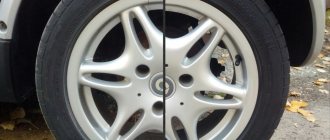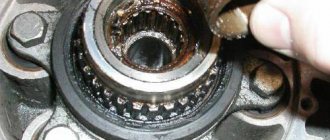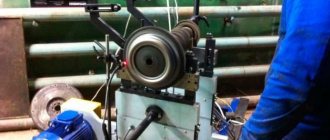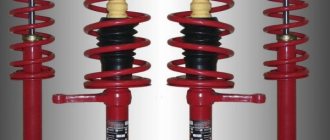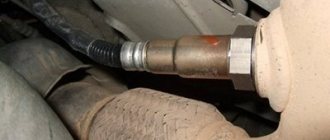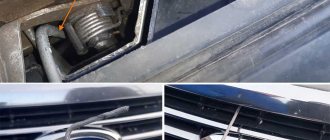Hi all. Today in the “Useful Tips” section - silent blocks. You will learn what silent blocks are, what they are intended for, and most importantly, how to press and press silent blocks at home in various ways.
What is a silent block?
The word “ silent block ” is of foreign origin; translated from English “silent” means silence and “block” means detail. A silent block or “silent” is a rubber-metal part; in other words, it is two bushings connected to each other by a thick layer of durable rubber. This invention, in addition to providing comfortable and silent movement in a car, has a number of advantages that I cannot list.
What are silent blocks needed for?
- Silent blocks prevent beatings and vibrations that occur during vehicle movement between various parts of the chassis and engine compartment.
- They protect parts from wear and tear by damping vibrations.
- They dampen vibrations coming from the wheels and chassis, thereby ensuring a soft and comfortable ride.
And these are just the main advantages of silent blocks; in fact, there are many more of them. However, today we will talk a little about something else, namely how to repair a car with your own hands, press out and press in silent blocks without damaging the part and your car.
When and why to change silent blocks?
Replacing silent blocks is most often done after the driver begins to notice a deterioration in the driving characteristics of his car or after the appearance of extraneous sounds (knocking, creaking, grinding), indicating the need to replace the silent blocks. Also, damaged silent blocks are often discovered during chassis diagnostics on a vibration stand.
If the silent blocks are not replaced on time, the owner risks even more breakdowns, which one way or another will arise due to faulty “silents”. For example, due to one damaged silent block, the load begins to be distributed unevenly, resulting in generation in other connections and nodes. As a result, instead of just one bushing, you will have to fork out money to replace all the silent blocks of the rear or front suspension.
Moreover, one should take into account the fact that a faulty suspension affects: a deterioration in the level of comfort, increased fuel consumption, increased tire wear, and also increases the braking distance, as a result of which the risk of an accident seriously increases.
Main characteristics of the press
Photo of a self-made silent block press
In addition to pressing out and pressing in automobile bearings or silent blocks, your own hydraulic press can perform a wide range of car repair, maintenance and maintenance work with your own hands.
Therefore, if you prefer to repair the car yourself, we recommend making a hydraulic press for this purpose. You can use ready-made press drawings, or adapt the device to your specific requirements and tasks.
Before you make a hydraulic unit to replace silent blocks, focus on the main characteristics of this equipment. When developing the device, the following parameters are taken into account:
- Equipment dimensions;
- Total weight of the device;
- Press piston stroke indicators;
- The presence of a pressure gauge (to create a controlled force or pressure);
- Hydraulic machine bed parameters.
There are many options for press design. Therefore, you should think about which hydraulic unit is suitable specifically for your car. Some people have a compact machine weighing about 1 ton in their garage. Others may have a multi-ton truck. You understand that the simplest press with the minimum parameters of the force generated will not be able to cope with the truck.
Many people decide to make a device based on a simple bottle hydraulic jack with a built-in hand pump.
Press diagram
Drawing of a homemade silent block press
Before purchasing a hydraulic jack itself to make a press for pressing in various silent blocks or bearings, select a suitable device design.
There are two great options for a hydraulic press:
- The hydraulic jack is mounted on the base of the working bed of the press and presses upward;
- The jack is installed on top of the bed. The device creates pressure, but in this case downward.
Most home craftsmen prefer the first version of the press. The second type of scheme is relevant for some plumbing work.
Please be aware that some hydraulic jacks are sometimes not designed to be installed upside down. Therefore, before choosing, make sure of this.
Press design features
The hydraulic press has several important design features that are taken into account during the creation of the drawing and directly during assembly of the device.
- Press stand. It is a frame inside which a hydraulic jack will apply pressure to the parts. Therefore, increased strength requirements are imposed on the frame. The frame must have a margin of safety so that the jack rod can effectively put pressure on the part, but not deform the frame. The bed additionally serves to create stability for your structure. It is better that the bed has the shape of a platform.
- The height of the hydraulic machine directly depends on the size of the hydraulic jack used, the required parameter of the free stroke of the rod and the height of the silent blocks. Don't forget to take into account the thickness of the table. According to the first diagram mentioned above, the force of the jack rod is transmitted to the part through a work table with a movable structure. It installs on top of the hydraulic jack on the bed. It moves up and down. The work surface is supported by guides installed on the sides.
- On both sides of the press hydraulic jack there are tension springs of sufficient power. One eye clings to the base of the frame, and the other to the movable work table. The function of the springs is to compress the jack to its initial position when the rod is not extended.
- If we consider the second diagram of the press, then the stop of the silent blocks being processed is the base of the frame. The jack is fixed on the working movable table of the machine, which is suspended on the frame using tension springs.
- In the two proposed press designs, a socket is made under the rod head. It needs to be made at the interface nodes. In the case of the first scheme, from below the table, and in the second scheme, from above the frame. For these purposes, you can use a section of a metal pipe. The main thing is that the element has the required diameter.
An important point when developing a hydraulic press with your own hands is the ability to adjust the free play at the device rod. You also need to adjust the height of the parts as necessary when processing them. To do this, you can use the following options:
- At the top of the homemade press frame you can place a screw-type drive, complemented by a steering wheel. When screwing in the screw with the plate, the clearance for the workpieces being processed inside the frame is reduced;
- Use a removable stop for a hydraulic press that looks like a movable working surface. It is fixed to the frame with bolts and nuts. To do this, you need to drill a hole with a certain height increment;
- Use replaceable inserts-linings made of durable metal profiles;
- Combine the above options.
DIY hydraulic press assembly
If you decide to assemble a homemade press with your own hands, necessary for pressing silent blocks and bearings, you will need certain materials and tools.
Therefore, start by selecting the required components. Without them, it will be impossible to assemble a homemade press. You will need:
- Welding device with electrodes;
- Hacksaw for metal processing;
- Bulgarian;
- Hydraulic jack with suitable power parameters;
- Tension springs (springs from car seats or doors work well);
- Bridge mushroom with shifted splines (in case the jack is located at the bottom);
- Channels;
- Metal pipe with a square or rectangular cross-section;
- Metal corner;
- Steel sheet;
- Steel strip;
- A piece of pipe for the rod head.
You select the dimensions of the parts according to the selected drawings, or select them for your specific designed hydraulic press.
When everything is ready, you can start working with your own hands.
- Cut metal blanks according to the drawings.
- Make the necessary holes on the metal parts if the drawings provide for their presence. Drilling on an already assembled structure will be problematic.
- Weld all metal components that require the use of a welding machine. Handle the seams carefully as the hydraulic press will be subject to heavy loads. Your task is to make a U-shaped structure that is securely welded to the base.
- Next comes the movable table. To make it, use a pipe or channel. The pipe should have a length that is less than the intermediate distance between the two posts. Then another piece of pipe is welded, necessary for the hydraulic jack rod. Metal strips can act as guides. Their length should correspond to the width of the bed. The pipe should be placed between the posts. Guide strips are attached to the sides. Secure the structure with reliable bolts and nuts.
- To make an adjustable homemade removable press stop, proceed in the same way. But only make holes on the metal strips opposite the racks. This will allow you to fix the element at the desired height.
- According to the drawings, install the springs and use them to pull the movable work table.
- Place the jack in place. The structure is ready.
The advantage of such a hydraulic press for pressing is that, if necessary, the hydraulic jack can be easily removed and used independently. Using a self-assembled press, you can easily cope with replacing silent blocks and more.
Auto repair shop specialists and ordinary car enthusiasts know how important it is to have all the necessary tools on hand when servicing a vehicle.
Despite the fact that the time of independently “digging” in the car has almost passed, many car owners still perform basic tasks on their own.
For example, for experienced car enthusiasts it will not be difficult to replace silent blocks, but in order for this process to go without a hitch, it is better to purchase a special puller in advance.
How to choose the specified tool, what to look for and which popular models to pay attention to today - read below.
Necessary materials
To press this part at home, you will need the following tools:
- Scrap;
- Jack;
- A set of keys;
- The hinges are new.
It is recommended to use machine oil or other types of lubricant as a lubricant.
By the way, you will need special mandrels designed for pressing into silent blocks; as an alternative, you can use a piece of pipe of the required diameter. You will also need a press to insert the new metal zipper. At home, an ordinary vice can act as a press. In addition, you can stock up on a number of maces, but with this approach it is necessary to maintain high precision in the work.
How to choose
Of course, before moving on to choosing a specific puller for the front or rear silent blocks, you first need to understand what kind of device it is and what it is used for.
Appearance
There can be a wide variety of such tools, because today they are presented both as a separate C-shaped device with several attachments, and as whole sets, which include guide pins with nuts, sleeves and support disks for them.
There are also universal pullers and those designed for a specific car brand , which must be taken into account when purchasing.
A correctly selected product will help you easily cope with difficult work, since the silent block is quite firmly fixed in its seat and sometimes it takes a lot of effort to remove it.
Depending on the type of part (whether it is an element of the front suspension, stabilizers or fastening of torque rods) installed on a car or truck, a puller for removing silent blocks - elements that reduce rattling and noise when the vehicle is moving - will have its own characteristics.
Among the wide variety of domestic and foreign tools presented on modern markets, you can find absolutely any puller that will meet all the technical parameters of your machine and individual requirements (for example, cost).
However, the main task in any case remains the choice of a quality product that will serve faithfully for many years. Therefore, now we invite you to familiarize yourself with the list of characteristics that are worth paying attention to, and the list of features that are unworthy of it.
What to look for:
So, when choosing a silent block remover for VAZ cars or foreign cars, you should consider the following:
- the model of your car, unless, of course, you decide to buy a universal tool (by the way, there is an opinion that specialized products are much more durable than universal pullers, but in practice it all depends on the manufacturer);
- the presence of smooth edges in all threaded connections of special tools;
- absence of rough areas and open shells;
- ease of unscrewing and tightening detachable parts;
- the requirements of the selected model for other, additional tools, without which it cannot be operated;
- type of puller: manual or hydraulic (for personal use or for car maintenance in small workshops, the first option will be sufficient);
- Availability of instructions in a language you understand.
Licota ATC-2286
The set of silent block pullers is equipped with mandrels and cups of the most popular sizes, which are excellent for working with parts of domestic and foreign production.
Before using the puller, you only need to select a mandrel of the required size, install it on the element to be removed and perform dismantling by rotating the nut. Using the kit, the entire silent block removal process is quick and easy.
Characteristics:
- It is used for both pressing out and pressing in silent blocks.
- Internal mandrels: 34, 36, 38 – 70, 72, 75, 80 mm.
- Outer mandrels: 44, 46, 48 – 80, 82, 85, 90 mm.
- Pins: M10, M12, M14, M16, M18.
- Type: universal puller.
- Weight: 17 kg.
Pros:
- It has different attachments, making it suitable for different brands of vehicles.
- All parts are easy to assemble and disassemble.
- Possibility of dismantling and installing silent blocks.
- Convenient case for storing all puller parts.
Minuses:
- Relatively heavy weight.
- High price.
Video
This video shows how to make a silent block remover and how to work with it.
How to change silent blocks without a puller.
How to change silent blocks on the “classic” VAZ 2101, 2102, 2103, 2104, 2105, 2106, 2107.
How to make a puller for VAZ 2113, 2114, 2115.
How to make a puller for removing and installing rubber-metal hinges on Skoda Fabia, Skoda Rapid, VW Polo Sedan cars.
MASTAK 110-20026C
Another good option made in Taiwan. This impressive set consists of 26 elements, which allow it to be used to remove a wide variety of silent blocks and bearing races.
Characteristics:
- Availability of 20 mandrels with ø 44/34 (11 pieces) and ø 48/38 (9 pieces).
- The set also includes thrust washers (2 pieces) and 350 mm power bolts (M16x2.5, M14x2.0, M12x2.0, M10x1.5).
- Type: universal tool.
- Weight: 18 kg.
Pros:
- High-strength material for all parts.
- Possibility of universal use (suitable for various brands of cars).
- Suitable not only for silent blocks, but also for external and internal races of bearings.
- Convenient storage case.
Minuses:
- Price.
- The latches on the case do not always fit tightly.
- Weight.
FORCE 949T1
The model belongs to the hydraulic puller type, the set of which includes 49 items. With its help, you can easily disassemble the bushing and replace it (with the exception of parts without holes). Compared to the above puller options, FORCE 949T1 is lighter and easier to use.
Characteristics:
- The maximum load on the cylinder is 18.2 t.
- The comfortable and durable spindle has dimensions: Ø 16 mm, Ø 14 mm, Ø 12 mm, Ø 10 mm.
- Deep mandrels - 22 pieces (18 internal ones of 110 mm each and 26 external ones of 68 mm each).
- Short mandrels - 22 pieces (18 internal 40 mm and 26 external 68 mm).
- Bolts - 4 pieces (diameter 16, 14, 12, 10 mm).
- Type - hydraulic universal puller.
Pros:
- Convenient collars.
- Sturdy case with metal clasps.
- Strong ratchets.
- Long heads.
- The handles are made of high-quality material that is not corroded by technical liquids.
Minuses:
- All parts of the puller are sensitive to moisture and quickly rust when exposed to it.
- High price.
General operating principle of pressing tools
Everyone knows that a silent block, also known as a rubber-metal hinge, is a fairly dense part in its structure. Due to the presence of this property, such hinges cannot simply be inserted into the seat; they must be pressed into place. During the pressing process, it is important to use special tools that will allow you to press the silent block quickly without damaging its structure.
The general principle of operation of such devices is that they act on the part either from two sides (if such a possibility exists), or from one side, pressing it into the seat. In this case, the pressing tool uses the vehicle assembly into which the silent block is installed as a support. It is worth noting that regardless of the tool used, it is important to act extremely carefully. Otherwise, there is a considerable risk of damaging either the hinge itself or the part into which it is installed.
What is a silent block
This word is of foreign origin. Translated from English, silent means silence, and block means detail. A silent block, or simply “silent,” is a rubber-metal component; in ordinary words, these are two bushings that are connected to each other by a layer of durable rubber. This invention, in addition to guaranteeing comfortable and silent movement in a car, has a number of advantages that will be listed below.
Purpose and functions
Silent blocks perform the following functions:
- Protect components from wear and tear by damping vibrations .
- They dampen vibrations that come from the chassis of the wheels, thus providing a comfortable and soft ride.
- Prevent vibrations and beatings that appear during the movement of the car between different elements of the chassis and engine compartment.
And these are just the main advantages; in fact, there are many more.
Special tools
The simplest pressing option is to use a pre-purchased universal puller. Such a device helps not only to squeeze the part out of its seat, but also to press it back in. Depending on the design of the puller, it can be designed both for pressing silent blocks into parts with a one-sided hole, and with a double-sided hole.
Typically, pressing tools work according to the following principle:
- A “removable” bolt is inserted into the eye of the silent block, then a special or several special metal rings are put on it, which will press the hinge into its seat.
- Next, the person carrying out the repair begins to tighten a nut or several nuts, which will move the previously mentioned rings and, accordingly, press the part.
- Having achieved the required result, the entire instrumental structure is disassembled and, if necessary, the procedure is repeated for other silent blocks.
Ways to press in silent blocks
There are several options for pressing silent blocks.
Option with a vice
Before pressing the component, it is necessary to clean the seats from rust and burrs with sandpaper. Then lubricate the eyes with Litol lubricant or liquid soap. Place the part on top of the lever, place a special mandrel on it, and use a vice to press the component into the socket.
Pressing using a press
The silent blocks can be pressed in using the press puller that was used to remove the part. You need to select the necessary attachment for pressing, lubricate the eye, install the part correctly and press it, periodically checking so that the component does not go awry.
Press-out device
To make sure that components need to be replaced, you need to do a visual inspection of the rubber parts. They must be intact, without deformation. There should be no play when the car is rocking. When the car is moving, wear will be revealed by the knocking of the suspension, swaying of the body and unstable movement of the car.
To get a silent block at home, you need to:
- Place the lever under the press on the stand where the silent block will go. Place a spacer on top to press out the bushing and press out the part.
- Using a vice instead of a press, you can squeeze out silent blocks using the same method.
- You can use a hydraulic jack. To do this, you will first need to weld a frame from a corner or channel in the form of a rectangle, which is larger in height than the jack. Insert the two spacers listed above and raise the jack until the silent block is pressed into the mandrel. You need to choose a more powerful jack - 10-15 tons, because lifts with 3-5 tons may not help.
- In the absence of special devices, a homemade or factory press puller is used, which squeezes out the part using a bolt, washers, nut and two extensions. All these components must be durable and reliable. Using such a device, you can press out without dismantling the hub and lever.
Using brute force
If you don’t have any of the above devices at hand, you can use an ordinary hammer and screwdriver or some thick sharpened pin to press out the silent blocks. It must be driven between the bushing and the silent block. As a result, the bushing of the part is deformed inward, after which it will be possible to pull out the rubber band and knock out the silent block.
You can press out the part using a metal blade, a screwdriver and a hammer. To do this, you need to remove the inner sleeve and carefully saw through the silent block with a blade so as not to damage the lever. Then use a screwdriver to pull out the part.
Homemade devices
Of course, a special device for pressing silent blocks costs some money. But what to do if there is no money to purchase such a device? There is only one answer - use homemade tools for these purposes or improvised pressing methods.
The simplest, but at the same time effective devices for pressing in hinges, which are within walking distance, are as follows:
- Ordinary vice. They can be used if the part into which the hinge is pressed is not too bulky and can fit between the two compressive surfaces of the vice. The principle of their action is simple and based on compression. For pressing, it is necessary to lubricate the contacting surfaces and place them in a vice so that when the vice is twisted, the silent block is pressed into its seat. When carrying out this procedure, it is important to act carefully so as not to damage either the part or the hinge itself.
- Hammer . Let us note right away that this method is extremely risky and not always safe to use. Despite this, it is often used in makeshift garage repair conditions. Pressing the silent block in with a hammer is not difficult, the main thing is to carefully, using this tool, drive the hinge into its seat. Don't forget to use lubricant.
- Homemade devices. You will have to make these tools yourself. The principle of their operation is similar to that inherent in special devices from the store. However, it is worth understanding that the manufacture of such tools may require turning, cooking skills and special equipment. The simplest devices can be made according to the images below:
As you can see, the tool for pressing out and pressing in silent blocks is represented by a fairly wide range of devices. Which one is better will be chosen by each repairman individually. We hope the material presented above was useful to you. Good luck with the repair and on the road!
Useful tips for car enthusiasts
Silent block or rubber-mechanical hinge - two bushings (external and internal) between which there is a rubber or polyurethane insert. These hinges are used to connect parts in the suspension, as well as in the engine, gearbox and shock absorber mounting systems.
Due to the elastic force of rubber or polyurethane, peak loads that occur when hitting an obstacle, a hole, etc., are “damped.” Under normal operating conditions, the working life of silent blocks is 100 thousand km. But given the state of our roads, many of them do not survive half their term. The rate of destruction and wear of polyurethane/rubber is also affected by driving style: frequent collisions with obstacles or overcoming them with the brake pressed contribute to their rapid destruction.
How to determine that the silent blocks have collapsed and need to be replaced? Pay attention to the behavior of the car while driving and braking. If it doesn’t hold the road very well, if it leads in one direction or if it “yaws”, and such problems were not observed before, most likely it’s time for you to change the silent blocks. If the car makes an unpleasant squeak when rocking, it will also need to be replaced. And another symptom is premature tire wear. Often the destruction of rubber/polyurethane is visible to the naked eye: cracks, swelling and other deformations are visible.
